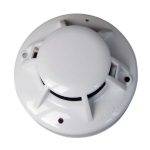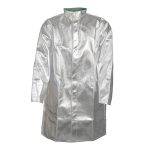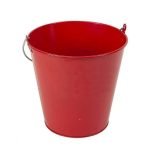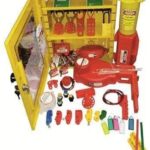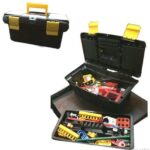Your list is empty, add products to the list to send a request
What Is the Golden Rule of Fire Extinguishers? Fire Safety Rules You Must Know

02
Jun
Fire extinguishers are essential tools in emergency preparedness, but owning one isn’t enough—you need to know how to use it safely and effectively. That’s where the golden rule of fire extinguishers comes into play.
This blog explores the golden rules, how to operate and stop a fire extinguisher safely, and expert safety insights to keep your home or workplace protected.
Understanding the Golden Rule of Fire Extinguishers
The golden rule of fire extinguishers is simple: Only attempt to fight a fire if it is small, contained, and you have a clear exit path.
Never endanger yourself or others trying to control a fire that is growing, spreading quickly, or producing a lot of smoke.
The 4 Essential Golden Rules of Fire Extinguisher Use
- Raise the alarm and call emergency services first
- Only use a fire extinguisher on small, contained fires
- Always keep your back to an exit for a safe escape
- Use the correct extinguisher for the fire type
These core principles help ensure safety while attempting to suppress a fire.
Using the PASS Method: A Practical Golden Rule
The PASS technique is universally recognized and represents the safest way to use a fire extinguisher:
- Pull the pin
- Aim low at the base of the fire
- Squeeze the handle
- Sweep from side to side
Maintain a safe distance (typically 6–8 feet) and approach the fire cautiously.
How to Close or Stop a Fire Extinguisher
Most fire extinguishers do not have an on/off switch. Once the handle is squeezed, it releases the extinguishing agent until the pressure is exhausted or you release the handle.
To stop a fire extinguisher:
- Release the handle (for stored pressure models)
- If continuous discharge occurs, the unit is likely empty or faulty and should be replaced or serviced
After use, do not try to manually repressurize or reseal the unit. Contact a certified technician.
Choosing the Right Fire Extinguisher Type
Using the wrong extinguisher can make a fire worse. Understand the basic classifications:
- Class A: Wood, paper, cloth (water or ABC dry powder)
- Class B: Flammable liquids (foam, CO2, dry chemical)
- Class C: Electrical fires (CO2 or dry powder)
- Class K: Cooking oils and fats (wet chemical)
Multi-purpose models like the Safety One Fire Extinguisher work on Class A, B, and C fires.
When Not to Use a Fire Extinguisher
Do not attempt to use a fire extinguisher if:
- The fire is spreading rapidly
- You don’t know what’s burning
- You lack proper training
- Your path to the exit is blocked
In these cases, evacuate immediately and call emergency services.
How to Stop a Fire Extinguisher After Use
After using an extinguisher:
- Lay it down horizontally to prevent rolling
- Do not attempt to reinsert the pin
- Notify building maintenance or a fire safety officer
- Send the unit for inspection and refilling
Extinguishers must be professionally recharged before being reused.
Safety Precautions When Using a Fire Extinguisher
- Read the label to know the extinguisher type
- Check the pressure gauge before use
- Avoid breathing in extinguishing agents
- Always face the fire from a safe distance
- If it doesn’t go out quickly, evacuate immediately
Common Fire Extinguisher Mistakes to Avoid
- Standing too close and getting burned
- Aiming at the flames instead of the base
- Not pulling the pin completely
- Using water on electrical or grease fires
Avoiding these mistakes can save time and reduce damage.
Maintaining Your Fire Extinguisher for Reliable Performance
To ensure your extinguisher works during an emergency:
- Inspect monthly for damage, corrosion, or leaks
- Check pressure (gauge should be in green)
- Replace or recharge immediately after use
- Hydrostatic testing every 5–12 years (based on type)
Store it in an easily accessible location, away from heat and moisture.
Ideal Fire Extinguishers for Home and Office Use
Choose a model that covers multiple fire types and is easy to operate.
We recommend the Safety One Fire Extinguisher, which is:
- Suitable for Class A, B, and C fires
- Compact and easy to store
- Ideal for residential and commercial settings
- Rechargeable and compliant with Indian standards
Training Staff and Family on Fire Extinguisher Safety
Basic fire extinguisher training should include:
- Identifying fire types
- Operating using the PASS method
- Recognizing when not to engage a fire
- Safe evacuation protocols
Practice through fire drills and refresh training at least once a year.
Conclusion: Follow the Golden Rules, Stay Safe
Knowing the golden rules of fire extinguisher use helps you respond confidently and safely during emergencies. From understanding when to use it, how to operate it, and how to stop it safely, these basics can save lives.
Equip your home or workplace with trusted tools like the Safety One Fire Extinguisher for dependable protection.
FAQs
1. What are the golden rules of fire extinguishers?
Only use extinguishers on small fires with a clear exit route. Always call for help first, use the correct type, and apply the PASS method.
2. How to close a fire extinguisher?
Release the handle to stop the discharge. Do not attempt to reinsert the pin. Have the extinguisher professionally serviced afterward.
3. How to stop a fire extinguisher?
Let go of the handle if it’s a stored pressure model. If it continues spraying, the unit is empty or faulty and should be replaced or inspected.
Ready to take fire safety seriously?
Explore the Safety One Fire Extinguisher for reliable, easy-to-use protection today.





